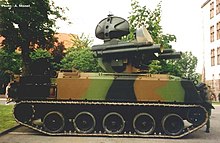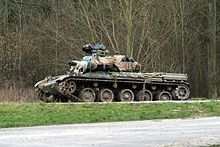AMX-30
| AMX-30 | |
|---|---|

AMX-30 in French barracks in Germany (1997/98) |
|
| General properties | |
| crew | 4 (commander, driver, gunner, loader) |
| length | 9.5 m (with pipe overhang) |
| width | 3.1 m |
| height | 2.5 m |
| Dimensions | 36 t |
| Armor and armament | |
| Armor | 79 mm (front armor) |
| Main armament | 1 × 105mm cannon |
| Secondary armament | 1 × 7.62 mm MG 1 × 20 mm MK (coaxial) |
| agility | |
| drive | water-cooled 12-cylinder multi-fuel engine Hispano-Suiza HS110 507 kW (680 PS) |
| suspension | Torsion bar |
| Top speed | 65 km / h |
| Power / weight | 14.1 kW / t (18.9 PS / t) |
| Range | 500-600 km |
AMX-30 is the type designation of a French main battle tank . It was the most successful French tank during the Cold War and the backbone of the French army for over 30 years .
history
After comparative tests with the Batignolles-Châtillon Char 25T , the AMX-30 was favored. In 1955, the French company GIAT Industries began construction of the AMX-30 main battle tank , which was to replace the American M47 tanks . The first prototypes were completed in the early 1960s and 2300 AMX-30s have been delivered since then. The tank has an automatic fire control system and can fire projectiles at an exit speed of 1525 m / s. Due to its low weight and lower armor compared to others of its development time, the vehicle is also classified as a medium battle tank. This is also due to the fact that the vehicle should be used in less favorable ground conditions than in Europe. The AMX-30 was not only used as a battle tank, but also self-propelled howitzers , anti-aircraft tanks and reconnaissance tanks were produced on the chassis .
The AMX-30 was the French draft for the Franco-German standard tank project (the Leopard was its German counterpart), which aimed to create a standard tank for the European NATO countries. In extensive tests and a comparison test of the AMX-30 with the then nameless German standard tank and later Leopard 1 , which took place under Italian management in September 1963 in Mailly-le-Camp , both types proved to be relatively equivalent, with the Leopard being somewhat stronger was armored, had the better engine block and overall had greater development potential. In addition, the French side preferred the self-developed 105 mm DEFA cannon. Since it cannot fire any of the NATO types of ammunition, the other NATO countries rejected the AMX-30. The main ammunition used was a grenade with a twist-jacket stabilized hollow charge, which has a high penetration rate against conventional armor. With the appearance of composite armor and reactive additional armor , this special ammunition lost a large part of its effectiveness. Therefore, the French were forced to develop a sub-caliber projectile in order to continue to be able to fight tanks effectively.
Versions
- AMX-30 D: armored recovery vehicles
- AMX-30 AuF1 : 155 mm self -propelled howitzer
- AMX-30 EBG: Engineer tank
- AMX-30 ROLAND: Roland anti-aircraft missile system on AMX-30 chassis
- AMX-30 PLUTON: Pluton missile on AMX-30 chassis
- AMX-30 B2: AMX-30 with improved fire control system
- AMX-30 DT: (Démineur Télécommandé) mine clearance tank
- AMX-30 BRENUS: AMX-30 with reactive armor
- AMX-30 FORAD: Only external changes to the representation of foreign / enemy tank units in maneuvers
- AMX-32 : Prototype of an export version with stronger armor, but at the expense of mobility
- AMX-30EM2: In 1987 Spain began to modernize 150 units: more powerful engine, automatic gearbox, shock absorber, fog-throwing system, side bars, Hughes MK-9 fire control system with thermal imaging camera
Use in other armies
-
 Bosnia and Herzegovina 15 AMX-30
Bosnia and Herzegovina 15 AMX-30 -
 Chile 60, including 19 AMX-30B1 and 39 AMX-30B2 (retired in 2006)
Chile 60, including 19 AMX-30B1 and 39 AMX-30B2 (retired in 2006) -
 France 387 AMX-30 and 659 AMX-30 B2 (retired)
France 387 AMX-30 and 659 AMX-30 B2 (retired) -
 Greece 102 AMX-30 B2 (retired)
Greece 102 AMX-30 B2 (retired) -
 Qatar 24 AMX-30 S.
Qatar 24 AMX-30 S. -
 Croatia 42 AMX-30
Croatia 42 AMX-30 -
 Saudi Arabia 290 AMX-30 S and AMX-30 SA
Saudi Arabia 290 AMX-30 S and AMX-30 SA -
 Spain 210 AMX-30 (retired)
Spain 210 AMX-30 (retired) -
 Venezuela 81 AMX-30V
Venezuela 81 AMX-30V -
 United Arab Emirates 64 AMX-30
United Arab Emirates 64 AMX-30 -
 Cyprus ( National Guard ) 113 AMX-30 - of which 52 AMX-30 B2
Cyprus ( National Guard ) 113 AMX-30 - of which 52 AMX-30 B2
Trivia
Due to the space requirement of the secondary armament in the form of a 20 mm MK , which is rather rare for battle tanks , compromises had to be made in the spaciousness of the tank. The fighting area, but also the driver's seat and its entrance, are extremely narrow.
See also
Web links
- http://www.fas.org/man/dod-101/sys/land/row/amx-30.htm
- http://www.kotsch88.de/f_amx-30.htm
- http://www.army-guide.com/eng/product.php?prodID=2071
Individual evidence
- ↑ Approx. 30 vehicles are kept at the military training areas to represent the enemy



